Outsourcing's New Reality: Choice Beats CostOutsourcing's New Reality: Choice Beats Cost
Creative CIOs are getting not only savings but also added flexibility and specialized skills from their IT outsourcers. Just don't expect magic.

Outsourcing. It's the hottest of hot-button issues this electoral season. Small wonder. Along with "the 99%" and "entitlements," it's a loaded, often misrepresented or misunderstood term that encapsulates many of the political, economic, and social issues of the day--including class, foreign policy, immigration, employment, and national security.
Critics lambaste outsourcing as a way for big corporations to replace workers with less-expensive contractors, sometimes (but not always) located in offshore locations with much lower wages. Make no mistake--outsourcing IT operations can reduce costs. Sixty-seven percent of the 289 outsourcing customers in our 2012 State of IT Outsourcing Survey rated cost savings as an outsourcing benefit of 3 or higher, on a 1-to-5 scale where 5 is "primary benefit"; 22% said it's the primary benefit.
But the notion that IT outsourcing is merely a way for companies to slash payroll is, if it ever was true, no longer valid. Even officials in the Obama administration, a critic of outsourcing, admit as much. "On the U.S. side, the outdated perception of an Indian economy that detracts from U.S. production and output is widely seen as an anachronism," said Geoffrey Pyatt, the State Department's deputy assistant secretary, speaking in Chennai, India, last November. Indeed, the cost advantages of shipping work to India, in particular, have eroded as salaries have risen 10% to 15% or more in just the past year, according to various estimates.
Most CIOs now want more from their outsourcers than just a quick boost to the bottom line. They want partners that can help them innovate, give them more business flexibility, and deploy scarce IT resources where and when they're needed. "The magic of outsourcing is giving us the ability to focus on those areas where we can be truly great," says survey respondent Robert Isherwood, CTO at ad agency 22squared.
Like most utilities, Consumers Energy wants to apply breakthroughs in big data processing and analytics to do a better job of monitoring and predicting its customers' energy usage. Doing so will mean lower costs and more reliable service. Its problem was that most employees in its 100-plus-person IT department were too busy with the day-to-day work of maintaining the utility's existing software and systems to work on more strategic projects.
Mamatha Chamarthi, CIO of Consumers Energy, knew the Jackson, Mich., utility needed to bolster its IT resources, but she also knew that finding and hiring more full-time people would be difficult. Really--in Michigan? Turns out that nearby General Motors, under new CIO Randy Mott, is grabbing many of the area's available IT pros as the automaker pulls much more of its tech work in-house and moves away from outsourcing. "It's tough to get good talent right now," Chamarthi says. "The autos are recovering, and no one looks at a utility as a sexy place to work. With Randy Mott around, GM is going to hire everyone who has any bit of IT knowledge."
That reality led Chamarthi to seek an outsourcer. Her goal: Find a company that could take over Consumers Energy's routine IT work in order to free up in-house staff for projects in smart grid, mobility, and analytics. "It was not a cost play," she insists. "It was more about how much business value we were leaving on the table."
After a bidding process that involved 10 vendors, Consumers Energy tapped HCL Technologies for work that will require the India-based outsourcer to build a technology center in Jackson to serve the utility and, eventually, other local companies. HCL's Michigan Technology Development Center, which is scheduled to open by year's end, will initially employ about 100 people and plans are for it to grow to more than 400 over the next few years.
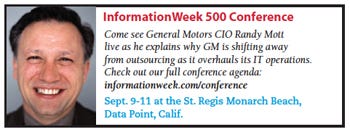
The HCL center will take over support of Consumers Energy's SAP application environment, support the utility's other business apps, and perform break/fix work. "A lot of people think of outsourcing and they think you are taking jobs and shipping them somewhere," Chamarthi says. "We are reskilling our employees, moving them onto strategic projects. We're not laying off our employees. We're building additional capacity by bringing in a partner."
Chamarthi says a key reason she chose HCL over other outsourcers was that the company made a commitment to building a facility in Michigan and hiring locals. "We didn't look at this from a political angle," she says. "We thought: What are our core values? Our core values are to invest in Michigan."
Consumers Energy may be the exception in requiring local work from its offshore IT outsourcer, but it isn't alone in its belief that outsourcing is an effective way to tap a broader pool of IT talent. Some 69% of the respondents to our survey rated the ability to deliver projects beyond what could be done by in-house staff a 3 or higher; 22% gave it a full 5. "If it wasn't for offshore vendors, we would struggle to get the work done in the time required," says survey respondent Carolyn Anderson, operations director at GTESS, a provider of insurance claims processing technology.
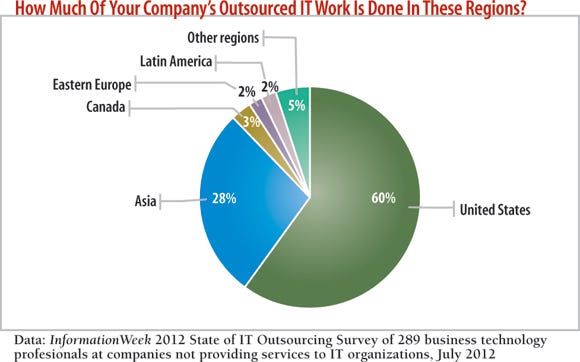
Use On The Rise
The worldwide IT outsourcing market grew 7.8% last year, to $246.6 billion in total revenue, according to Gartner. Among respondents to our survey who use outsourcers for customer application development, 72% said their use of outsourcers will either increase or stay the same in the next 12 months, while only 13% planned to cut back (and 15% were undecided).
Ready access to tech talent is just one reason companies are turning to tech outsourcers in greater numbers. Another reason is to get help modernizing their IT infrastructures. Most companies maintain proprietary applications that still need to be updated for the Web and the cloud.
One such company is Aramark Uniform Services, a Burbank, Calif., division of food services company Aramark Corp., which counts among its core applications an aging billing and invoicing system. That system was developed almost 30 years ago in Cobol and runs on the VAX operating system, a relic from the days when Digital Equipment Corp. ruled corporate computing.
The company is moving to an off-the-shelf, Java-based accounting system, but that transition will take two to three years. The 15 or so Aramark software engineers who maintain it know that the move will cost most of them their jobs. CIO Patrick Piccininno was concerned that some of them would leave before the switch is completed, as Cobol programmers are a vanishing breed in high demand.
So Piccininno looked for an outsourcer that could take over system maintenance and upgrades until the new package goes live. Hewlett-Packard was already physically hosting the system at a facility in Colorado Springs, so he opted for an HP software team based out of Bangalore, India. "We turned to HP, not because we wanted to save money, but because we needed an organization we could count on, who could manage and run this legacy application until we were successfully transitioned," Piccininno says. "HP has a very deep bench of experienced Cobol and VAX expertise." (VAX developer DEC was acquired by Compaq, which was acquired by HP.)
Some of Aramark's Cobol programmers are moving to HP; others will be laid off. "These folks have a very good niche skill, and I know they have marketability," Piccininno says. "That's based on the fact that we've had a very difficult time finding good, competent people who can work in this environment."
Aramark also plans to outsource its IT help desk operations. "It's inherently difficult for internal organizations to be really good at running a help desk," Piccininno says. "Help desks typically experience a high level of turnover. We're trying to focus our organization on those areas where we can competitively differentiate ourselves."
In Transition
Aramark isn't alone in using outsourcing as a way to get through a technology transition. Some 52% of respondents to our survey rated smoother project delivery a 3 or higher. Some, however, have caveats. "The only time I would ever use outsourcers or vendors is to fill in gaps with our IT plans," says survey respondent Robert Miller, CIO at customs brokerage The American Cos.
So which functions are CIOs most comfortable turning over to outsourcers? The most outsourced area is application development, cited by 80% of our survey respondents, followed by application maintenance (74%), hardware maintenance and support (61%), data center operations (60%), network monitoring and support (57%), and end user support (53%)
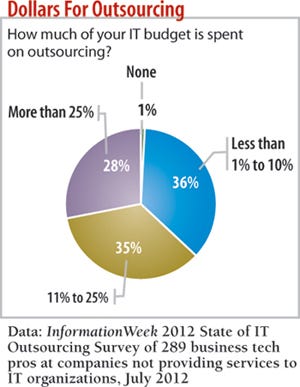
As shown, labor flexibility and access to a wider talent pool are among the key benefits of outsourcing. Others identified in our survey include the ability to deliver projects more quickly, produce a better quality product, and access industry-specific expertise. Some 13% of respondents even said outsourcing's most important benefit for them is for accounting--letting them move certain IT spending from a capital expense to an operating expense.
No question, cutting costs is still a major motivator. Take Mexico-based concrete and construction supplies company Cemex. Deeply in the red following the housing market collapse and an ill-timed, $16 billion acquisition of Australia's Rinker, Cemex is trying to slash its debt load, which sat at $17.2 billion as of June. The plan calls for Cemex to turn over most of its IT operations, including infrastructure management and application development and maintenance, to IBM, a move that Cemex VP Roberto Chaverri says will save the company more than $100 million a year over the life of the 10-year contract.
Under a business process outsourcing component of the deal, IBM will take over and run Cemex's finance, accounting, and human resources systems. The deal is so extensive that Chaverri will take on a new title, moving from VP of corporate IT to VP for vendor management.
Some of Cemex's IT employees will move to IBM, which beat out 16 other outsourcers for the contract. Others will stay with Cemex, while still others will be laid off. "We don't have the final numbers yet," Chaverri says.
Cemex's main goal is to cut costs, but Chaverri says the handoff to IBM will provide other benefits. "This will allow us to focus more on our core business," he says. "With IBM's economies of scale and breadth of services, they can better serve transactional activities to our external and internal customers."
How Things Go Wrong
Cost savings, access to skilled labor, more time for core projects: What's not to like about outsourcing? Well, there's no shortage of examples of how things can go wrong.
For example, IBM's eight-year, $55 million deal to develop an Oracle and WebSphere-based billing system for Texas utility Austin Energy, signed in 2009, has been plagued by missed deadlines, cost overruns, and buggy software that generated bills that overcharged residents. Ironically, the system, part of a larger smart grid effort, was supposed to help customers save money. Austin Energy CIO Alan Claypool, who inherited the IBM contract, says outsourcing vendors need to know there will be consequences if they don't perform. "The penalties around specific areas like system availability need to be much stronger," Claypool told information in an interview earlier this year.
An intranet upgrade contract the Navy and Marine Corps awarded EDS (before Hewlett-Packard acquired EDS in 2008) became infamous for cost overruns and delays. And the U.K. government has all but scrapped a $17 billion project to build an electronic healthcare network that was supposed to introduce e-health records and let patients manage their care online. Accenture quit the contract in 2006 after losing millions on it, and another prime contractor, Computer Sciences Corp., earlier this year confirmed that it would write off $1.5 billion in costs related to the effort, which was years behind schedule and billions over budget.
Experienced CIOs say IT outsourcing deals often go awry because management on the customer side assumed that its responsibility for the work ended when the ink dried on the contract. "Outsourcing doesn't simply mean lobbing the responsibility to a third party," says Aramark's Piccininno. "Quite frankly, I believe it increases your level of accountability. One of the ways we mitigate risk at its core is that we are heavily invested in and involved with what HP does for us."
Another recipe for disaster is when companies outsource too much. Veteran CIO Jim Ditmore, senior VP for infrastructure services and innovation at insurer Allstate, says too many of his peers are willing to turn over not just routine tasks, but also crucial functions, to outsiders. "For most large companies, their products and services are far more dependent on IT than they were 20 or even 10 years ago," Ditmore says. "One of the ways you differentiate now is by adding new capabilities through technology. If you're heavily outsourced, you're limiting your ability to do that. You're no longer the prime innovator."
Allstate now uses a number of outsourcers worldwide--3,000 to 4,000 contract workers do everything from application development to coding and testing. But the insurer is reining in many of those deals. Much of the work will be moved to company-owned, "captive" tech centers Allstate is establishing in India.
Captive centers, used to some extent by 43% of the respondents to our survey who use offshore IT services, offer the benefits of offshoring without the disadvantages of outsourcing, Ditmore argues. "In this age, every large company really should be driving to leverage a global engineering capability," he says. "You'll get a higher caliber of talent, and local, nearshore, and offshore resources. You'll be able to address global tastes and differences, and take advantage of the clock."
Ditmore notes that Allstate's developers in India will be able to code and test applications overnight and have them ready for stateside workers to deploy in the morning.
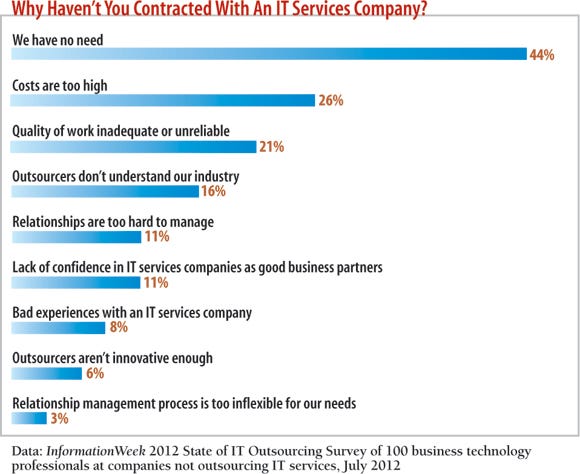
Where In The World
Even with rising costs in India and gains by IT outsourcers in Eastern Europe, Latin America, and other regions, India remains the top spot for offshoring. Among our survey respondents, 28% of their companies' outsourced work is done in Asia, while just 2% is done in Eastern Europe and 2% in Latin America.
Outsourcing isn't synonymous with offshoring; survey respondents say 60% of the outsourcing work done for their companies is done in the U.S. Says survey taker D.G. Brown, CIO at electronics manufacturer Sparton: "We use an onshore company after having major issues with an offshore company. The offshore company did not test, provided substandard product, and exhibited major communications gaffes."
Another downside to pure outsourcing, Ditmore says, is that IT organizations lose their institutional knowledge base. "There's no pipeline of talent coming up," he says. "You lose the context of how work is being done."
The most common reason IT pros give for not outsourcing? Forty-four percent said they have no need. After that, it's cost (26%), followed by quality of work (21%), lack of industry knowledge (16%), and the difficulty of managing these relationships (11%). The main reason Mott is reversing GM's historical reliance on IT outsourcing is to execute projects faster and cultivate auto technology expertise internally.
With all the pros and cons, it's no wonder that IT outsourcing is, and will remain, controversial--even if it has become more than just a cost-cutting move. Ditmore offers advice for fellow IT execs: "Everything in moderation. When you can get some advantages, absolutely. But to go fully into it and assume it's just going to work is naive."
More Outsourcing Reading:
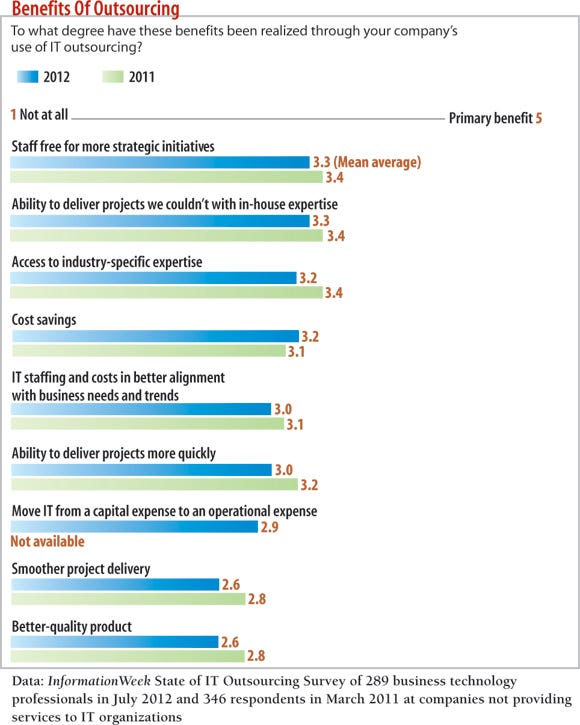

information: Sept. 3, 2012 Issue
Download a free PDF of information magazine
(registration required)
About the Author
You May Also Like






